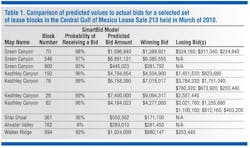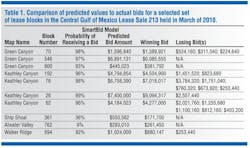Neural network notices anomalies in seismic data
Gene Kliewer • Houston
Tom Smith and Geophysical Insights are bringing an advanced mathematical analysis method to bear on seismic interpretation. The concept of unsupervised neural networks is being extended to seismic interpretation to speed interpretation and direct the interpreter's attention to the key areas in the data that represent the anomalies being sought as indicators of possible hydrocarbon-bearing zones.
To get a better understanding of the process,Offshore magazine visited with Smith to peek behind the curtain to see how a self-organizing map can benefit exploration.
Offshore: When you say neural network, what do you mean? How does it work?
Smith: The inspiration for the fellow who had this breakthrough was inspired by the brain and the visual cortex in particular. The big breakthrough was to think about a learning process which would be incorporated into a two-dimensional map of neurons – computer "neurons" in this case.
Here we're thinking about a neuron as a little depository of information. That repository is based upon what gets to it. The neuron network is presented a set of information and the neurons adapt themselves to the information presented to them.
The neurons adjust to the characteristics of the data following a set of straightforward rules. This results in what are called self-organizing maps (SOMs).
The input data can be completely unclassified (without reference "ground truth") and the learning progression is unattended.
Large volumes of data can be evaluated by an unsupervised neural network quickly, making their use reasonably practical. They can also be programmed to operate unattended and report by exception when anomalies are detected.
The unsupervised neural network works without any supervision at all. Wells are not required for this process.
Offshore: What data do you start with?
Smith: Normally these days we might start with four or five cubes of data, each a seismic attribute. The old standard is the seismic amplitudes. Today, interpreters work commonly with at least five and as many as 30 different attributes, all derived from a single amplitude. Those are then all input into this unsupervised neural network process.
There are two parts to this process. The first part is the learning. That literally is taking the attribute cubes and presenting those to the neurons. You end up with an SOM. After this self-training, the second step is to then apply the results of the two dimensional map.
How we apply it is to go back to the data cube and take every single data point from those original data cubes and compare them to the neural network result. We find the neuron that is the closest…that learned it was the best match to that particular sample. We keep this process up. We go through all the samples in the original data, not just the amplitude but all the attributes, and we do a comparison. This is the classification process. Once we're done with that we will have taken every piece of our input data and found it nearest neighbor…the neuron that is the closest match.
Offshore: What about the math involved in the program?
Smith: If you think about a particular point in a 3D survey, if you've got five attributes, you've got five numbers associated with that point in the image. Mathematically, that just a little column vector. So if it's five attributes, the neuron is also a column vector that has place for five numbers.
We have done a good deal of design and development of the technology. Today, we are delivering the results of our analysis to clients on a turn-key basis. We also have been making substantial investments in reseasrch and development. Going forward, Geophysical Insights will announce a dramatic, commercial-grade software framework and applications that use unsupervised neural network technology.
So, our work in geobodies has demonstrated the ability to automatically identify areas that don't fit, where the material is substantiallly different than its surroundings, and differentiate between noise and valuable information. We find those areas, the dimensions, and rank them as to size and shape, and deliver those. Once we have a geobody, we go back and post it in the original volume. If this is a geobody with some shape, that's what makes it an anomaly.
Offshore: Why is your technology being called "disruptive"?
Smith: We have good evidence that it will substantially reduce the risk and time associated with the interpretive process. This new technology has great potential to "disrupt" the industry by providing a tool that comes close to the direct detection of hydorcarbons.
Editor's note: For more, see story on page 40.
Offshore Articles Archives
View Oil and Gas Articles on PennEnergy.com


